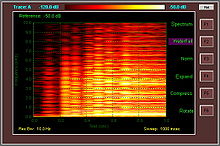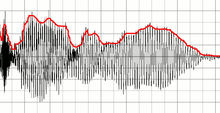- Timbre
-
Not to be confused with Timber.
In music, timbre (
 /ˈtæmbər/ tam-bər or /ˈtɪmbər/; French: [tɛ̃bʁ]) is the quality of a musical note or sound or tone that distinguishes different types of sound production, such as voices and musical instruments, such as string instruments, wind instruments, and percussion instruments. The physical characteristics of sound that determine the perception of timbre include spectrum and envelope. In psychoacoustics, timbre is also called tone quality and tone color.
/ˈtæmbər/ tam-bər or /ˈtɪmbər/; French: [tɛ̃bʁ]) is the quality of a musical note or sound or tone that distinguishes different types of sound production, such as voices and musical instruments, such as string instruments, wind instruments, and percussion instruments. The physical characteristics of sound that determine the perception of timbre include spectrum and envelope. In psychoacoustics, timbre is also called tone quality and tone color.In simple terms, timbre is what makes a particular musical sound different from another, even when they have the same pitch and loudness. For instance, it is the difference between a guitar and a piano playing the same note at the same loudness. Learned musicians are able to distinguish between different instruments based on their varied timbres, even if those instruments are playing notes at the same pitch and loudness.
Timbre has been called a "wastebasket" attribute (Dixon Ward, 1965)[1]) or category (Tobias 1970, 409), or "the psychoacoustician's multidimensional wastebasket category for everything that cannot be qualified as pitch or loudness" (McAdams and Bregman, 1979).
Contents
Synonyms
Tone quality and color are synonyms for timbre, as well as the "texture attributed to a single instrument". Helmholtz used the German Klangfarbe (tone color), and Tyndall proposed an English translation, clangtint. But both terms were disapproved of by Alexander Ellis, who also discredits register and color for their pre-existing English meanings (Erickson 1975, 7).
The sound of a musical instrument may be described with such words as bright, dark, warm, harsh, and other terms. There are also colors of noise, such as pink and white.
In visual representations of sound, timbre corresponds to the shape of the image (Abbado 1988, 3).
American Standards Association definition
The American Standards Association definition 12.9 of timbre describes it as "that attribute of sensation in terms of which a listener can judge that two sounds having the same loudness and pitch are dissimilar", and a note to this definition adds that "timbre depends primarily upon the spectrum of the stimulus, but it also depends upon the waveform, the sound pressure, the frequency location of the spectrum, and the temporal characteristics of the stimulus" (American Standards Association 1960, 45).
Attributes
Many commentators have attempted to decompose timbre into component attributes. For example, J. F. Schouten (1968, p. 42) describes the "elusive attributes of timbre" as "determined by at least five major acoustic parameters", which Robert Erickson (1975) finds "scaled to the concerns of much contemporary music":
- The range between tonal and noiselike character.
- The spectral envelope.
- The time envelope in terms of rise, duration, and decay (ADSR—attack, decay, sustain, release).
- The changes both of spectral envelope (formant-glide) and fundamental frequency (micro-intonation).
- The prefix, an onset of a sound quite dissimilar to the ensuing lasting vibration.
(Erickson 1975, 6) gives a table of subjective experiences and related physical phenomena based on Schouten's five attributes:
Subjective Objective Tonal character, usually pitched Periodic sound Noisy, with or without some tonal character, including rustle noise Noise, including random pulses characterized by the rustle time (the mean interval between pulses) Coloration Spectral envelope Beginning/ending Physical rise and decay time Coloration glide or formant glide Change of spectral envelope Microintonation Small change (one up and down) in frequency Vibrato Frequency modulation Tremolo Amplitude modulation Attack Prefix Final sound Suffix See also "Psychoacoustic evidence" below.
Harmonics
The richness of a sound or note produced by a musical instrument is sometimes described in terms of a sum of a number of distinct frequencies. The lowest frequency is called the fundamental frequency and the pitch it produces is used to name the note. Other significant frequencies are called overtones of the fundamental frequency, which may include harmonics and partials. Harmonics are whole number multiples of the fundamental frequency, such as ×2, ×3, ×4, etc. Partials are other overtones. Sometimes there are also subharmonics at whole number *divisions* of the fundamental frequency. Most western instruments produce harmonic sounds, but many instruments produce partials and inharmonic tones, such as cymbals and other indefinite-pitched instruments.
When the orchestral tuning note is played, the sound is a combination of 440 Hz, 880 Hz, 1320 Hz, 1760 Hz and so on. The balance of the amplitudes of the different frequencies is a major factor in the characteristic sound of each instrument.
William Sethares wrote that just intonation and the western equal tempered scale are related to the harmonic spectra/timbre of many western instruments in an analogous way that the inharmonic timbre of the Thai renat (a xylophone-like instrument) is related to the seven-tone near-equal tempered pelog scale in which they are tuned. Similarly, the inharmonic spectra of Balinese metallophones combined with harmonic instruments such as the stringed rebab or the voice, are related to the five-note near-equal tempered slendro scale commonly found in Indonesian gamelan music (Sethares 1998, 6, 211, 318).
Envelope
The timbre of a sound is also greatly affected by the following aspects of its envelope: attack time and characteristics, decay, sustain, release (ADSR envelope) and transients. Thus these are all common controls on synthesizers. For instance, if one takes away the attack from the sound of a piano or trumpet, it becomes more difficult to identify the sound correctly, since the sound of the hammer hitting the strings or the first blat of the player's lips are highly characteristic of those instruments. The envelope is the overall amplitude structure of a sound, so called because the sound just "fits" inside its envelope: what this means should be clear from a time-domain display of almost any interesting sound, zoomed out enough that the entire waveform is visible.
Timbre in music history
The music of Debussy, composed during the last decades of the nineteenth and the first decades of the twentieth centuries, has been credited with elevating the role of timbre in music: "To a marked degree the music of Debussy elevates timbre to an unprecedented structural status; already in Prélude à l'après-midi d'un faune the color of flute and harp functions referentially" (Samson 1977,[page needed]).
Psychoacoustic evidence
Often listeners are able to identify the kind of instrument even across "conditions of changing pitch and loudness, in different environments and with different players". In the case of the clarinet, an acoustic analysis of the waveforms shows they are irregular enough to suggest three instruments rather than one. David Luce (1963, 16) suggests that this implies "certain strong regularities in the acoustic waveform of the above instruments must exist which are invariant with respect to the above variables". However, Robert Erickson argues that there are few regularities and they do not explain our "powers of recognition and identification". He suggests the borrowing from studies of vision and visual perception the concept of subjective constancy (Erickson 1975, 11).
Psychoacoustic experiments from the 1960s onwards tried to elucidate the nature of timbre. One method involves playing pairs of sounds to listeners and then using a multidimensional scaling algorithm to aggregate their dissimilarity judgements into a timbre space; the most consistent outcomes from such experiments are that brightness or spectral energy distribution (Grey 1977), and the "bite", or rate and synchronicity (Wessel 1979) and rise time (Lakatos 2000), of the attack are important factors.
See also
References
- Abbado, Adriano (1988). "Perceptual Correspondences: Animation and Sound". MS Thesis. Cambridge: Massachusetts Institute of Technology.
- American Standards Association (1960). American Standard Acoustical Terminology. New York: American Standards Association.
- Dixon Ward, W. (1965). "Psychoacoustics". In Audiometry: Principles and Practices, edited by Aram Glorig, 55. Baltimore: Williams & Wilkins Co. Reprinted, Huntington, N.Y.: R. E. Krieger Pub. Co., 1977. ISBN 0882756044
- Dixon Ward, W. (1970) "Musical Perception". In Foundations of Modern Auditory Theory vol. 1, edited by Jerry V. Tobias,[page needed]. New York: Academic Press. ISBN 0126919011.
- Erickson, Robert (1975). Sound Structure in Music. University of California Press. ISBN 0-520-02376-5.
- Grey, John M. (1977). "Multidimensional Perceptual Scaling of Musical Timbres". The Journal of the Acoustical Society of America 61(5):1270–77. doi:10.1121/1.381428
- Lakatos, S. (2000). "A Common Perceptual Space for Harmonic and Percussive Timbres". Perception & Psychophysics 62(7):1426–39. PMID 11143454.
- Luce, David A. (1963). "Physical Correlates of Nonpercussive Musical Instrument Tones", Ph.D. dissertation. Cambridge: Massachusetts Institute of Technology.
- McAdams, Stephen, and Albert Bregman (1979). "Hearing Musical Streams". Computer Music Journal 3, no. 4 (December): 26–43.
- Samson, Jim (1977). Music in Transition: A Study of Tonal Expansion and Atonality, 1900-1920. New York: W.W. Norton & Company. ISBN 0-393-02193-9.
- Schouten, J. F. (1968). "The Perception of Timbre". In Reports of the 6th International Congress on Acoustics, Tokyo, GP-6-2, 6 vols., edited by Y. Kohasi,[Full citation needed]35–44, 90. Tokyo: Maruzen; Amsterdam: Elsevier.
- Sethares, William (1998). Tuning, Timbre, Spectrum, Scale. Berlin, London, and New York: Springer. ISBN 3-540-76173-X.
- Wessel, David (1979). "Low Dimensional Control of Musical Timbre". Computer Music Journal 3:45–52. Rewritten version, 1999, as "Timbre Space as a Musical Control Structure".
Footnotes
Cadence · Interval · Melodic motion · Motif · Ornament · Voice · Phrase · Pitch (music) · Rhythm · Steps and skips · TimbreOpera terms Aria · Aria di sorbetto · Arioso · Bel canto · Breeches role · Burletta · Cabaletta · Cadenza · Cantabile · Castrato · Cavatina · Chest voice · Claque · Coloratura · Comprimario · Convenienze · Coup de glotte · Da capo aria · Diva · Divertissement · Duodrama · Entr'acte · Fach · Falsetto · Falsettone · Fioritura · Gesamtkunstwerk · Head voice · Hovsångare · Intermezzo · Kammersänger · Leitmotif · Legato · Libretto · Literaturoper · Mad scene · Maestro · Melodrama · Melodramma · Messa di voce · Monodrama · Musico · Opera house · Overture · Passaggio · Portamento · Prima donna · Prompter · Recitative · Regietheater · Répétiteur · Ritornello · Sitzprobe · Spinto · Sprechgesang · Squillo · Stagione · Surtitles · Tessitura · Timbre · Travesti · Verismo · VibratoTimbre Vocal music Types · Genres 
Voice classification Concepts · Techniques Coloratura · Chest voice · Falsetto · Head voice · Passaggio · Sprechgesang · Tessitura · Timbre · Vocal pedagogy · Vocal range · Vocal register · Vocal resonation · Vocal weight
Categories:- French words and phrases
- French loanwords
- Timbre
- Opera terminology
Wikimedia Foundation. 2010.


